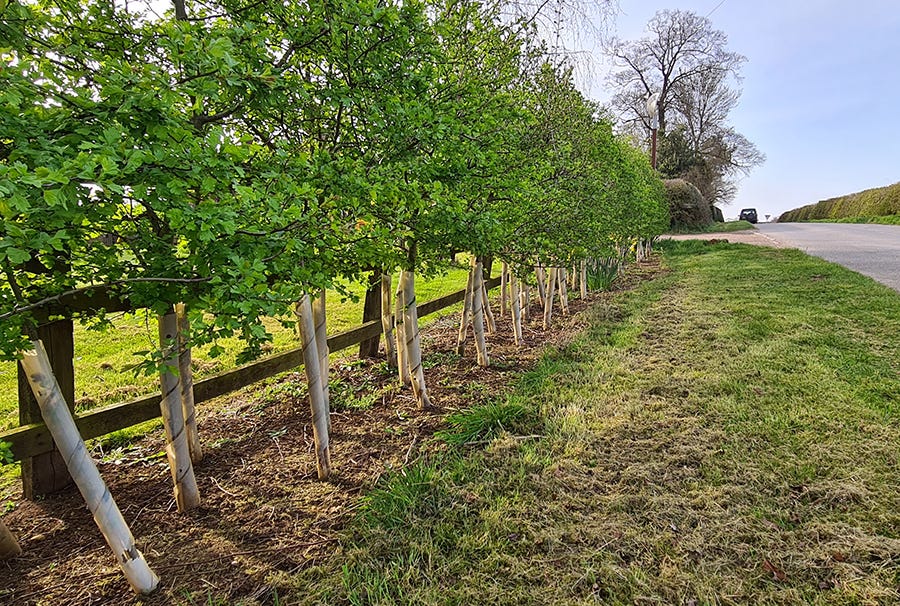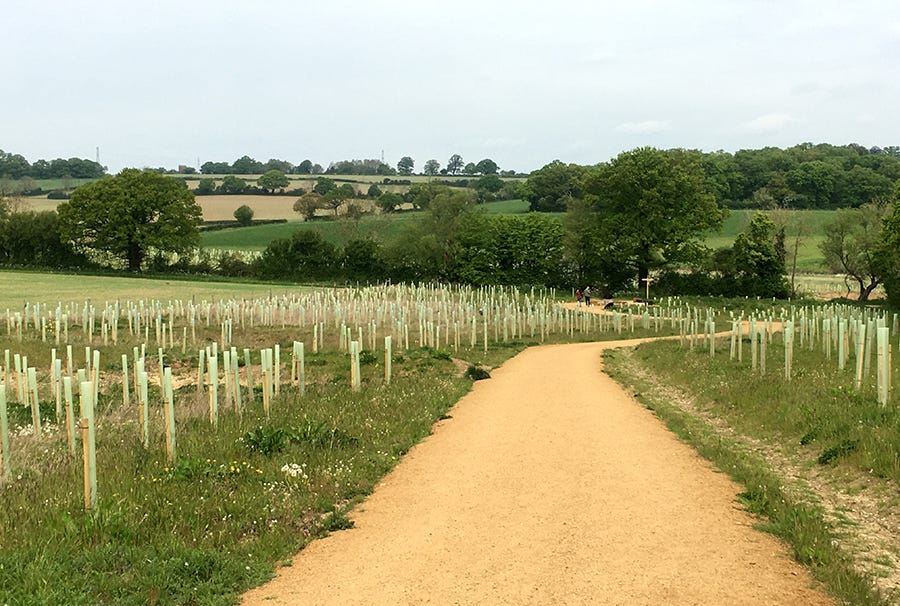Tree Guards Part 1: Plastic
It's more complicated than it looks
Over the next few years, millions of new trees will be planted across the country to help with biodiversity and climate challenges impacting Britain and our planet. Suitable protection for young trees is a conversation that is developing, as guards constructed from new materials are brought to market. Those planting have a responsibility to select tree protection which will not leave a lasting negative impact on the landscape. However, the matter is complex and a simple, widely-accepted solution does not yet exist. In this two-part Substack article, The Tree Council team discuss some of the issues to consider when selecting which guards to use – first we assess the complexities of plastic guards, while the next edition of Tree Talk will explore cardboard guards.
For the purposes of this article, let’s assume you’ve made the decision that some kind of individual tree protection is totally essential to establish your trees successfully. There’s a whole other conversation to be had about different ways to protect trees, or what to protect them from, which I won’t go into here.
I think we can all agree that microplastics are harming the environment and are a problem. I’m not suggesting it’s a good idea to always use plastic tree protection - indeed, some of my colleagues would say you should never use it. For me, what is important is to make informed decisions about it. The problem is the information is complicated.

So, what is plastic?
We think we all know right? But do we? Plastics can be bio-based or fossil-based polymers, biodegradable or non-biodegradable, in pretty much any permutation. It is, for example, possible for a plastic to be both fossil-based and biodegradable, and indeed for a plastic to be bio-based and non-biodegradable. Bio-based plastics can also be made of either naturally occurring bio-polymers (like cellulose or proteins) or artificially synthesized from naturally occurring base macromolecules (like oils are starches). Add to that issues around ethical sourcing and sustainability of base materials and disposal and it all becomes very confusing very fast.
“But the problem is tree guards need to remain robust outside, in all weathers, often for several years, which can present a challenge for many compostable materials”
In some ways the ‘best’ kind of plastic shelter or guard would be a compostable one (i.e. one that completely decomposes quickly – to defined standards of time and extent in order to achieve certain certifications) made from a renewable and ethically sourced base material. But the problem is tree guards need to remain robust outside, in all weathers, often for several years, which can present a challenge for many compostable materials. I think I’d ideally like an endlessly reusable option which already exists – be it wire, robust plastic or other materials.
It concerns me that people buy and use tree shelters and guards when they’re not always essential for a planting project. It also concerns me that people buy things they think are more eco-friendly without being fully informed and understanding all the implications. It’s nobody’s fault, it’s just complicated.

End of life
I do question whether it is appropriate to leave a shelter or guard in the environment at all (is it littering?) but, assuming we have agreed that is essential, there are the following factors to consider.
Not all bioplastics will completely decompose under normal outdoor conditions, and often require industrial facilities, so you still have to treat them like traditional plastic. They need to be removed and disposed of appropriately. Bioplastics which do make their way to industrial composters may be removed from the composting process anyway – because they may not decompose to the required standard fast enough – and sent to landfill or incinerated.
“Bioplastics which do make their way to industrial composters may be removed from the process anyway – because they may not decompose to the required standard fast enough – and sent to landfill or incinerated.”
It may not be appropriate to mix bioplastics with normal plastic in recycling facilities, adding another layer of potential confusion and room for error. Traditional fossil-based plastics are by comparison relatively easy to reuse and recycle (notwithstanding the biosecurity and practical implications of reusing and recycling them).
Cost
We can’t ignore the issue of cost. I’m talking about money here. Traditional plastic is usually cheaper than alternatives, but there are other costs to consider (carbon costs and other whole life issues). A 2021 study by Chau et al suggested that bioplastics have a greater carbon footprint at manufacture and that, in the usage scenarios they examined, traditional polypropylene shelters, fully recovered and 100% recycled, were the least detrimental type of shelter to use. I would always ask myself what the end goal is. Is it better in the long run to have a healthy and well-established tree that you’ve only had to produce once, buy once, transport once and plant once, even if it means having reusable plastic wrapped around it for a few years?

Do the alternatives work?
Lots of people are trying alternatives to traditional plastic but there’s little scientific evidence about their effectiveness yet. Forest Research is leading on research investigating a variety of individual tree protection devices being brought to the market, but the evidence won’t be published for several more years.
The Woodland Trust pledged not to utilise single-use plastic tree guards on its land by the end of 2021, and is currently investigating the best alternatives available.
Finally
For the time being, I think I prefer to base decisions on the facts at hand, not hopes of the new. Don’t lose sight of the end goal: established, healthy trees. This is ultimately a good thing for the planet. We should, absolutely, do what we can to reduce plastic use and always remove and recycle everything, in the proper way. There are probably other ways to effect the change we need – prosecutions for littering, clarity on what ‘biodegradable plastic’ is, and perhaps free schemes for collection and recycling – but that’s another story!
Jackie Shallcross is The Tree Council's lead for the Shared Outcome Fund Trees Outside Woodlands project, in collaboration with Defra, Natural England and five local authorities. Find out more about The Tree Council at treecouncil.org.uk





Helpful, but people need to be aware that when planting fruit trees, they need to be protected throughout their lives as the bark is a tasty treat for deer and rabbit. So that rules out biodegradeable guards. They also need to have an open-mesh guard as solid guards can cause problems for bark development. Recycled open-mesh plastic guards seem the best solution currently. Chicken-wire is good, but there is more chance of injury to the user with this.
Anybody planting trees with guards, should allow for funding or arrange for voluntary groups to remove them once they are no longer required